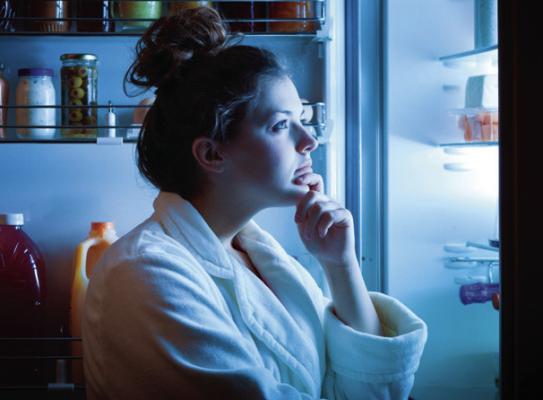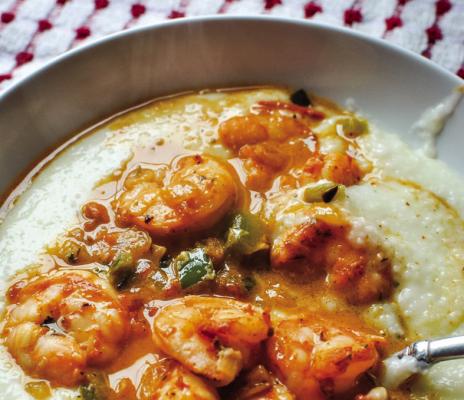Eating Before Bed
What about that late-night snack? Is it OK to eat and then go to bed? Will it make you gain weight?
It’s a controversial topic, and the common perception is that we should avoid eating late, as it could cause weight gain. That’s because some feel that the body doesn’t have time to digest the food before sleep, resulting in the body storing the food as fat rather than it being immediately used as energy. Others feel eating before bed confuses our circadian rhythm. But if you haven’t eaten enough calories throughout the day, a bedtime snack might be needed.
When we sleep, our metabolism may slow down 10% to 15% compared to during waking hours, says Melissa Prest, registered dietitian and spokesperson for the Academy of Nutrition and Dietetics. She recommends stopping eating two to three hours before bedtime to help the body digest food. It’s important to eat enough during the day to feel full and satisfied. Our bodies need to rest and repair at night.
Research in the Journal of Obesity finds that those who eat a large meal close to bedtime tend to skip breakfast because they are still full and are also more likely to be overweight. The Journal article, “The Association of Having a Late Dinner or Bedtime Snack and Skipping Breakfast with Overweight in Japanese Women,” was published in March 2019. Researchers at Tokyo’s National Institutes of Biomedical Innovation looked at 19,687 Japanese women ages 40-74 and found participants’ eating behaviors (eating a late dinner, bedtime snacks, skipping breakfast) were associated with an increased risk of being overweight or obese.
Eating a carbohydrate-rich meal close to bedtime may cause your body to store the calories as fat rather than use them as immediate fuel, says Prest. She explains that spikes in insulin signal the body to store fat for energy reserves. As metabolism slows at night, having a large, sugary treat triggers insulin.
Rather than choosing a treat high in fat or sugar, she recommends a light snack that includes fiber and protein, such as an apple with a tablespoon of peanut butter or a piece of string cheese with a whole-grain cracker. The fiber helps to slow the rise of glucose after eating and the protein helps with muscle repair and healing.
It’s also best to eat a larger meal earlier in the day rather than too close to bedtime, or it may be more difficult to fall asleep. However, if you go to bed hungry, you may struggle to fall asleep.
The bottom line is: Eat enough calories -- but not too many -- throughout the day with plenty of fruits, vegetables, whole grains, lean protein, low-fat dairy and water.
Q and A Q: How can I give allergenfriendly treats to children at Halloween?
A: The best idea is to keep allergen-friendly treats in a separate bowl from candies that may contain allergens (such as tree nuts, milk, wheat, soy and eggs). When children come to the door, let them know you have allergen-friendly candies as an option. You can also give nonfood items such as small toys, pencils or stickers.
RECIPE My son-in-law is from the South where grits are a staple. On a recent visit, he made grits for all of us. Here’s a similar recipe for shrimp and grits from Hy-Vee’s Seasons magazine.
SHRIMP AND GRITS Servings: 6 3 cups water 1 cup whole milk 1 cup quick 5-minute grits 1/4 cup shredded sharp cheddar cheese 2 pounds frozen peeled and deveined raw shrimp (13 to 15 count), thawed 1 tablespoon olive oil 1/2 (12 ounce) package fully cooked smoked andouille chicken sausage, sliced 1/4inch thick 1 (8 ounce) package baby bella mushrooms, sliced 1/4inch thick 1 cup chopped white onion 1/2 cup chopped red bell peppers 2 medium jalapeno peppers, seeded and chopped 2 cloves garlic, minced 1 (12-ounce) bottle spicy beer 1/2 cup mushroom-chicken bone broth 2 teaspoons lemon zest 3 tablespoons fresh lemon juice 1 teaspoon smoked paprika 1 teaspoon chopped fresh chives Combine water and milk in a 3-quart saucepan; bring to boil. Slowly whisk in grits. Cover and reduce heat to medium-low. Cook 5 to 7 minutes or until slightly thickened, whisking occasionally. Remove from heat; stir in cheddar cheese and set aside. Meanwhile, peel shrimp and remove tails. Pat dry with paper towels. Heat olive oil in a deep, 12-inch nonstick skillet. Add shrimp; cook over medium-high heat for 3-4 minutes or until shrimp reaches 145 degrees F, turning often. Transfer shrimp to a plate and set aside. Add sausage, mushrooms, onions, red peppers, jalapeno peppers and garlic to the same skillet. Cook over mediumhigh heat for 3-4 minutes or until softened, stirring occasionally. Remove skillet from heat. Add beer, bone broth, lemon zest and juice and smoked paprika. Return to heat; bring to a boil. Reduce heat to medium. Simmer, uncovered, for 6 to 8 minutes or until reduced by onethird. Stir in shrimp. Ladle grits into individual bowls and top with shrimp mixture; garnish with chives. Season with additional salt and pepper to taste. Serves 6.
Per serving: 370 calories; 33 grams protein; 31 grams carbohydrates; 12 grams fat (4.5 grams saturated); 205 milligrams cholesterol; 3 grams fiber; 5 grams sugar (0 grams added); 840 milligrams sodium.
Charlyn Fargo is a registered dietitian with SIU Med School in Springfield, Illinois. For comments or questions, contact her at charfarg@aol. com or follow her on Twitter @ NutritionRD. To find out more about Charlyn Fargo and read features by other Creators writers and cartoonists, visit the Creators website at www.creators. com.



